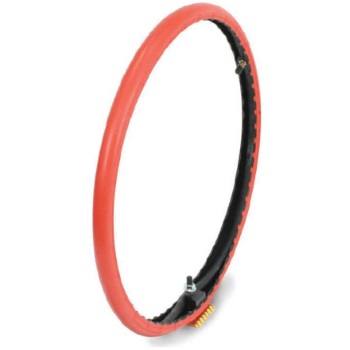
The flat tire.
A dreaded inconvenience, at best; the end of your Moto, at worst. It happens. Less so on a Motocross or Supercross track though it's not out of the ordinary. Usually, the enduro or off road rider encounters a pinched tube or a straight up blow out after a brutal punch into a boulder or other debris with a sharp edge.
Changing the tire on the fly isn't that easy. Plus you need the tools. Most trail riders plan for the flat and carry along the necessary tools and an extra tube, just in case. Clearly, it's one thing when you're having fun and time isn't of the essence it's another during any sort of timed trial.
Regardless, eliminating the flat tire probably ranks high on most riders' wish list whether they race or spend a lazy afternoon trailblazing. In recent years, several manufacturers have attempted to solve the flat tire conundrum with mixed results. Each offers something better than the other but the available solutions work for some and not for others. We're talking about the heavy duty tube vs. the TUbliss system vs. the mousse.
Pros and Cons of the Mousse
Michelin broke ground (Bib Mousse) and remains the leader but (Artrax ) also offers a mousse type insert and several other companies do as well. The benefits? A mousse pretty much eliminates flat tires. Seriously you could thrust a knife into one a la Dexter and you'd keep riding without losing performance.
Additionally, off road riders find when hitting rocks or logs the impact is dramatically reduced as the sponge-like foam softens these heavy impacts. This goes a long way in preventing fatigue over the course of a three hour race.
The Bib Mousse System
As for the downside, Michelin's bib mousse retains the tire "pressure" level at 13 psi. So, if conditions demand higher or lower psi the bib mouse inserts might give you fits. The G-Mousse gives a 12-14 or 14-16 psi feel depending on model. Both companies claim exclusivity with their mousse but if you can figure out the sizing both work in other tire brands. They're also much more expensive than the tube system - $125 for Michelin and nearly $200 for Goldentyre - though eliminating the fear of getting a flat, especially an ill-timed one, is completely worth it.
The mousse system requires a bit of maintenance, too. You can't simply install it and forget it. You'll need to regularly add lubrication. You also might blow a (mental) gasket trying to install them. They're a pain and require lots of patience otherwise find someone to put them in. But like anything, practice makes perfect.
New to the mousse family is Nuetech's Nitro Mousse. The same company that brings you the TUBliss System (see below) spent 10 years researching the mousse and designed one that eliminates the "dead" feel some riders complain about and the break-in period by using highly concentrated nitrogen.
Pros and Cons of the Heavy Duty Tube
The heavy duty tube is simply a thicker version of the traditional inner tube. It installs just like an inner tube and several thicknesses exist allowing you to decide on one or another depending on conditions. These tubes pose a far less expensive option than the highly priced mousse and stand up to pretty rough conditions. Many riders report never having a flat after installing a heavy duty tube.
The downside is tubes are tubes. You'll get a springy feel when hitting objects and they're still not puncture resistant. Installation is easier than the mousse, but it's certainly not a breeze. The problem many riders have when installing tubes is pinching and the thicker versions have a greater tendency to do that.
Pros and Cons of the TUbliss System
The TUbliss system is similar to the mousse but instead of filling-up the tire it acts more like a rim that locks and seals into place. Like the mousse it eliminates the need for a tube but unlike the mousse it allows pressure changes, as low as 0 psi on certain tires and used most often in the 4 to 8 psi range. It resists tire punctures so think of it like a bullet proof vest for your tire.
The Nuetech TUbliss System
The downside is the expense ($100) and the work involved installing. It's not as involved like the mousse but don't expect to be riding on the TUbliss system in 30 minutes. It's also only available in three sizes at the moment.
If you're one of those riders always getting flats you might consider investing in a mousse or the TUbliss. Many Motocross pros use the bib mousse though not in every race and certainly it's a must-have when riding in hare scrambles or other off-road adventures. Keep in mind though the factory riders enjoy the benefit of someone else installing either of these systems.
At the same time, think about the cost involved (and relative ease of installation) because for significantly less money a heavy duty inner tube - you know the system that's been around for decades - works well for most riders.










